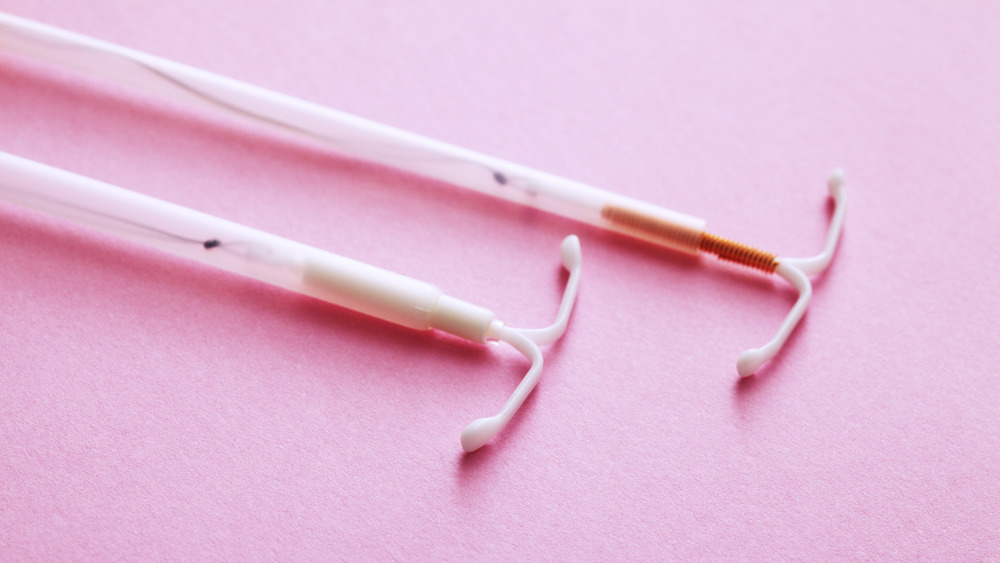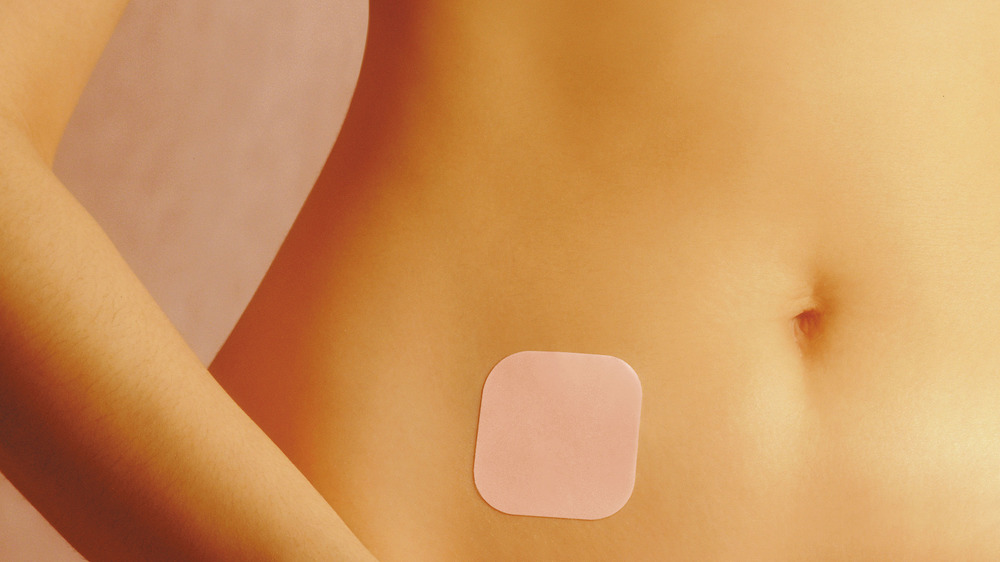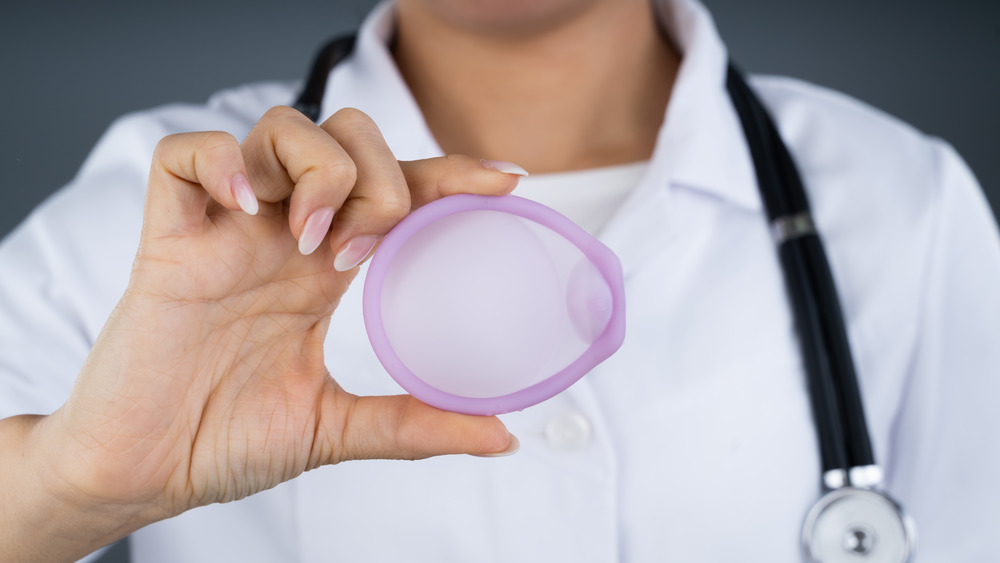Birth Control Methods You Should Actually Try For Preventing Pregnancy
Confirmation of a pregnancy can cause many people to teem with utter elation. Perhaps they've been actively trying to get pregnant, or maybe their pregnancy is a pleasant, welcomed surprise. Plenty of others, however, dread the sight of a positive pregnancy test. Whatever their concerns or reasons, they're valid. Because, of course, not all people want to be parents or give birth.
Nevertheless, data from 2011 found that nearly half of pregnancies in the United States are unplanned, the Guttmacher Institute explained. "Specifically, 27% of all pregnancies were 'wanted later' and 18% of pregnancies were 'unwanted,'" the institute explained. Of course, some such pregnancies happen despite careful preventive measures. A burgeoning body of research also supports that sex education could help prevent unplanned pregnancies — but not everyone has access to such resources.
Whether you want to get pregnant later or never, here are the most effective birth control options you should explore to avoid unwanted pregnancies the best you can.
The birth control pill is a popular method for preventing pregnancy
The birth control pill is a pretty popular option among a lot of women. While many take the pill for its added health benefits — from clearing acne to helping with premenstrual syndrome symptoms (PMS) — it's an effective choice for preventing pregnancies, too. In fact, 14 percent of women between the ages 15 and 49 take the pill, according to research by the Centers for Disease Control and Prevention.
Oral contraceptives work by stopping fertilization, as the hormones in the pill prevent you from ovulating, according to Planned Parenthood. Without ovulation, there are no eggs for sperm to fertilize, so pregnancy cannot occur. And because the hormones in birth control pills also thicken the mucus of your cervix, sperm would have trouble swimming to an egg even if there was one.
The pill would be considered 99 percent effective if taken properly: at the same time every single day. Forgetting to take your pill or not refilling your prescription on time could result in pregnancy, however. Because people just aren't perfect and this happens, the pill is realistically about 91 percent effective, according to Planned Parenthood.
Contraceptive implants can help prevent pregnancy
Contraceptive implants can help to prevent pregnancy from occurring. Some 10.4 percent of childbearing-aged women use long-acting reversible contraception, which includes the contraceptive implant, according to research by the Centers for Disease Control and Prevention.
These implants are flexible plastic rods that are placed under the skin in the upper arm, according to Mayo Clinic. They work by slowly and steadily releasing a low dose of the progesterone hormone that thickens your cervical mucus and thins the lining of your uterus, which is called the endometrium. When this happens, the sperm has a harder time reaching the egg dropped during ovulation. Typically, however, contraceptive implants will suppress ovulation, as well.
The implant is 99 percent effective, and you can choose to have it removed at any time and can get pregnant again soon after it's been taken out of your arm. "The implant is so effective because there's no chance of making a mistake," Planned Parenthood explained. "Since it's in your arm, you can't forget to take it, or use it incorrectly."
Female sterilization is a permanent procedure to prevent pregnancy
Female sterilization is a permanent form of birth control. According to the Centers for Disease Control and Prevention, 18.1 percent of women between 15 and 49 years old choose sterilization. The American College of Obstetricians and Gynecologists calls the sterilization procedure for women a tubal ligation.
A tubal ligation closes off your fallopian tubes, which prevents your eggs from moving down the tubes, keeping sperm from reaching them. Sterilization can be done in two ways: a minilaparotomy or a laparoscopy. In both methods, a surgeon cuts a small incision in your abdomen to reach the fallopian tubes to cut or close them off.
This is such an effective method that fewer than one out of 100 women will become pregnant within a year of having the procedure done. While the permanency of female sterilization can be considered ideal for preventing pregnancy, tubal ligation is not recommended for those unsure if they'll want children later on. You can have surgery to try to reverse the sterilization or try assisted reproductive technology (ART) in an attempt to get pregnant, but these procedures are not guaranteed to work.
Male sterilization is an effective permanent solution to prevent pregnancy
Male sterilization is a permanent form of birth control. According to research by the Centers for Disease Control and Prevention, 5.6 percent of women between 15 and 49 years old rely on male partners who've undergone sterilization in order to prevent pregnancy.
The American College of Obstetricians and Gynecologists calls sterilization procedures for men vasectomies. During a vasectomy, a man's vas deferens (which carry sperm from the testicles) are clipped, cut, tied, or sealed to prevent the release of sperm into their semen. When there is no sperm in the semen, the semen cannot fertilize the eggs.
After a vasectomy, it takes about two to four months for the semen to rid itself of sperm. Couples must use other forms of birth control to avoid pregnancy during this time. As the sperm count dwindles to zero, fewer than one out of 100 women will become pregnant within a year of the procedure. Although both vasectomies and tubal ligations are highly effective in preventing pregnancy, male sterilization is far less invasive. Like female sterilization, however, this procedure is not meant to be reversed; it is a permanent form of birth control.
The IUD is great at preventing pregnancies
The IUD (intrauterine device), a form of long-acting reversible contraception (LARC), is an increasingly common method of birth control. In fact, the IUD is widely used among women's healthcare providers, according to a study published in the journal Contraception. The study found that 42 percent of women's healthcare providers in the United States use LARC, and the IUD is the most popular of the bunch. While only 12 percent of women in the general U.S. population use such methods, the IUD is a highly effective option.
There are two types of IUDs, according to the Centers for Disease Control and Prevention. There's the levonorgestrel intrauterine system (LNG IUD), which is a small T-shaped device that's placed in your uterus and releases progestin every day. It can stay put for up to three to six years and only has a failure rate of 0.1 to 0.4 percent. Or there's the copper T intrauterine device, which is also a small T-shaped device that's placed inside the uterus, but it doesn't contain hormones. Rather, the copper's properties affect the sperm motility and egg survival. It can stay in your uterus for up to 10 years with a low failure rate of 0.8 percent.
The ring is a convenient birth control option
The vaginal ring is a convenient form of birth control that requires far less effort than remembering to take a pill every day, but that isn't quite as long-acting as some of the other birth control options on this list. The ring, more commonly known by its brand name the NuvaRing, is small and flexible. It bends so you can fold it into an oval and slide it inside your vagina, where it sits for three weeks and releases estrogen and progestin to stop ovulation and prevent pregnancy, according to Planned Parenthood. The ring's hormones also thicken the cervical mucus, which blocks sperm from reaching any eggs, as well.
Like the pill, it is considered 91 percent effective, and you have to remember to use the ring (though not quite as often) and refill your prescription. Any extra NuvaRings you may have (say, if you pick up a three-month supply with your prescription) must be stored at room temperature, away from direct sunlight. If they're going to be stored for longer than four months, however, you'll need to keep any extra rings in the refrigerator before use, Planned Parenthood advised.
You can wear a patch on your skin to protect against pregnancy
The birth control patch is placed on the skin to prevent against pregnancy. It works by releasing a daily dose of hormones — oestrogen and progestogen — through the skin and into the bloodstream. All you have to do is stick on your patch one time each week for three weeks. You do not wear the patch during week four (when you should menstruate). And you should check the patch daily, especially after you wash, swim in water, or use lotions, to make sure that the edges are still sticking properly.
There are two patch brands that are approved by the Food and Drug Administration: Twirla and Xulane. While the birth control patch is 91 percent effective in preventing pregnancies, it's not for everyone. The patch is geared toward women with a body mass index (BMI) below 30; women with higher BMIs are at a higher risk of developing blood clots with the patch.
The birth control shot can help prevent pregnancy for several weeks at a time
Depo-Provera birth control injections are shots of progestin that are required once every 13 weeks, which is how long each one will protect you against pregnancy, according to The American College of Obstetricians and Gynecologists. You'll need four injections per year, which your OB-GYN can give you. You can get the first one at any time during your menstrual cycle as long as you're not pregnant. If you get your period within the first seven days after the start of your period, you won't need to use backup birth control. If you get it after that, however, you'll need to use another contraceptive for the next week.
Because the shot injects progestin, it stops ovulation and thickens your cervical mucus, complicating the journey that sperm travels to fertilize an egg. If you get these injections every time you are supposed to, they're considered very effective. With perfect use, only one in 100 women will get pregnant during the first year of using the injection method. With typical use, however, six in 100 women will get pregnant. It takes about 10 months on average to get pregnant after the last injection.
Condoms can help prevent pregnancies and STIs
Condoms are probably the most widely known form of birth control. They have a 98 percent efficacy, according to Beth Israel Lahey Health Winchester Hospital. But that's only when they're used perfectly. When used typically, they're considered 82 percent effective. Condoms can break and slip off so it's important to be careful with them if they're the only form of birth control that you're using.
It's also important to note that condoms don't only help to prevent against pregnancy. Condoms also offer 90 percent protection against HIV, the Hepatitis B virus, and gonorrhea, according to research published in the Indian Journal of Sexually Transmitted Diseases and AIDS. They're also effective in preventing chlamydia, syphilis, trichomoniasis, and other sexually transmitted infections. Likewise, condoms can provide protection against even more diseases that can be transmitted via sex, such as the Zika virus and Ebola, according to the Centers for Disease Control and Prevention.
Cervical caps and diaphragms create physical barriers to prevent pregnancy
Cervical caps are soft silicone caps that you insert into the vagina to cover the cervix. The cap covers the cervix to stop sperm from reaching an egg, though it works best with a spermicide cream or gel that also kills the sperm, according to Planned Parenthood. You should leave the cap in place for at least six hours after the last time you had sex, but you shouldn't wear it for more than two days.
While diaphragms are a bit bigger and shaped more like dishes, they work in much the same way. Diaphragms are more effective (88 percent) than caps (71 to 86 percent), though they should only be left in for up to 24 hours. Make sure to wash your cap or diaphragm with soap and water after every use to avoid bacterial infections. Be sure to inspect it to make sure that there are no cracks or holes as well.
Spermicide can provide some birth control, but it isn't considered very effective when used alone
Spermicides can help prevent against pregnancy by killing off the sperm that enters the vagina. Spermicide, which comes in the form of gel, foam, cream, dissolvable film, suppository, and tablet, is inserted into the vagina before sex. While spermicides can help to prevent against pregnancy, there are some downsides.
For one, they're not all that effective on their own. In fact, about 21 out of every 100 women who use spermicides alone will become pregnant in a year of use, according to Harvard Health. So they work best when used with other barrier methods of contraception, like condoms, cervical caps, and diaphragms.
Secondly, the only spermicides that are approved by the Food and Drug Administration contain nonoxynol-9 (N-9), according to the National Women's Health Network. This damages the sperm's cellular membrane, but it can also damage the cells of the vagina with repeated use. This in turn can increase your risk of contracting and passing sexually transmitted infections.
Non-hormonal contraceptive gel can provide some birth control
One way to prevent against pregnancy is to use non-hormonal vaginal gel, which is inserted just prior to sex. The Food and Drug Administration has approved Phexxi as an option, which is made of a lactic acid, citric acid, and potassium bitartrate. According to the National Women's Health Network, Phexxi takes advantage of the vagina's natural acidity — which is measured by the pH balance — and the sperm's vulnerability to that environment.
Naturally, a healthy vagina pH ranges from 3.5 to 4.5, but semen can raise it to 7 or 8 to make the vaginal environment livable for sperm. Phexxi works by maintaining the vagina's natural, pre-sex pH balance so that sperm can't survive in it. The gel can be used on its own or in conjunction with other barrier methods of contraception.
Note, however, that non-hormonal vaginal gel is not the most effective form of birth control on its own. For approximately 15 women out of every 100 women, this method will fail, Dr. Shefali Pathy, an OB-GYN and professor at Yale School of Medicine, told Today.
Fertility awareness methods can be effective at preventing pregnancy
Fertility awareness methods (FAMs) rely on menstrual cycle tracking to help users know when they're ovulating, aka most fertile. According to Planned Parenthood, FAMs are 76 to 88 percent effective. Cycle tracking can also help you prepare for your period and better identify and understand any changes in your menstrual cycle that could be causes for concern. There are tons of apps to help you do this: Clue, Eve, Ovia, Flo, Glow, and more. In fact, in 2016 alone, menstrual apps were downloaded about 200 million times, according to research published in BMC Public Health.
But it's important to do your research to find which FAM works for you. You should also know that not every cycle tracking app out there is accurate. "Most free smartphone menstrual cycle tracking apps for patient use are inaccurate," researchers concluded in a 2016 study published in the journal, Obstetrics & Gynecology. "Few cite medical literature or health professional involvement."
Abstinence is one surefire way to avoid getting pregnant
Of course, the only 100 percent effective way to avoid pregnancy is by not having sex. Abstinence and outercourse cannot get you pregnant, according to Planned Parenthood. Abstinence is defined by no sexual activity at all. Outercourse, however, is defined by Planned Parenthood as "other sexual activities besides vaginal sex." Some kinds of outercourse, unlike abstinence, can spread sexually transmitted infections, but no kind can cause pregnancy "unless semen spills out into the vagina," the organization explained.
Some people practice abstinence or outercourse only on days when they know that they're fertile, which is known as a fertility awareness method. They still engage in sexual activities and have sex during other times throughout their cycle. Other people, however, choose to refrain from sexual intercourse altogether — and they may do so for a whole host of reasons that aren't necessarily just about preventing pregnancy.















